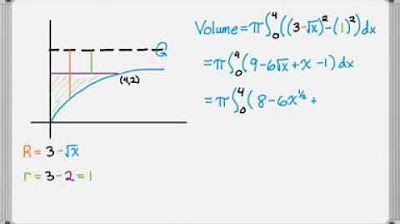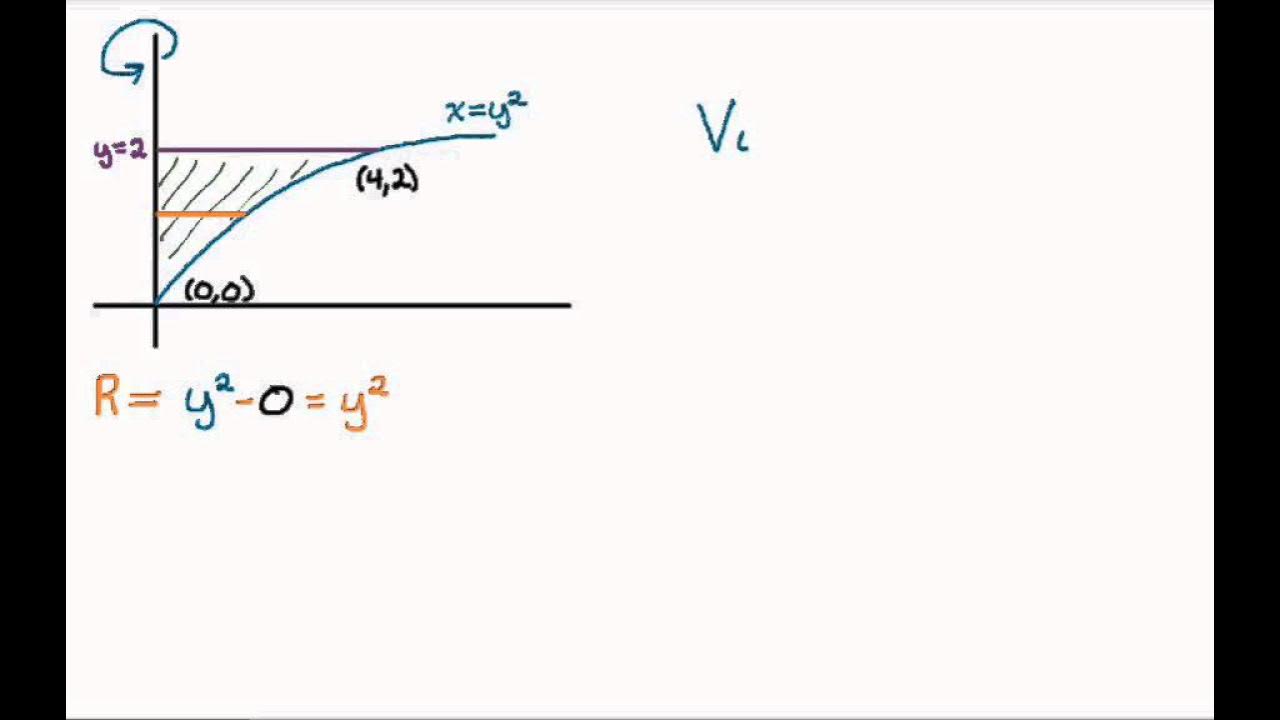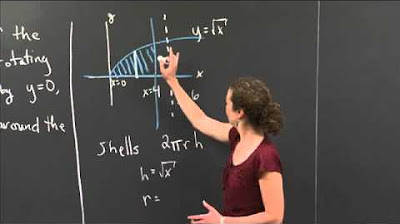Solid of Revolution (part 4)
TLDRIn this educational video, the focus is on calculating the volume of a solid formed by rotating a function around the x-axis. The example uses the functions y = sqrt(x) and y = x^2, which intersect at (0,0) and (1,1). The volume is found by integrating the difference in volumes between the two functions from x=0 to x=1. The process involves setting up and solving an integral equation, resulting in a final volume of 3π/10 for the described solid, illustrating the power of calculus in solving geometric problems.
Takeaways
- 📐 The topic is the rotation of functions around the x and y-axis, with a focus on calculating the volume of the resulting solids.
- 🌀 An example given is rotating the function y = √x around the x-axis to find the volume between the function and the x-axis from 0 to 1.
- 📈 The script introduces a more complex problem by adding another function, y = x^2, and rotating the region between these two functions around the x-axis.
- 🔄 The volume of the figure formed by the rotation of y = √x is compared to a hollowed-out cup due to the presence of the inner function y = x^2.
- 🤔 The concept is visualized by imagining the solid and the hole created by the inner function, which helps in understanding the volume calculation.
- 📊 The volume is calculated using integrals, with the total volume being the difference between the volumes of the two individual rotations.
- 🧮 The integral for the volume of the larger solid (y = √x) is π * ∫(x)^2 dx from 0 to 1, and for the smaller solid (y = x^2) it's π * ∫(x^4) dx from 0 to 1.
- 🌐 The script humorously compares the shape of the solid to traditional Moroccan tajin plates, highlighting the practical applications of mathematical concepts.
- 🔢 The antiderivative of x is (1/2)x^2 and of x^4 is (1/5)x^5, which are used to evaluate the integrals at the bounds 0 and 1.
- 📝 The final volume of the figure is calculated to be 3π/10, demonstrating the process of evaluating definite integrals to find volumes of solids of revolution.
- 🎥 The video script concludes with a teaser for the next topic, which involves rotating functions around the y-axis.
Q & A
What is the main topic of the video script?
-The main topic of the video script is the study of the rotation of functions around the x and y-axis, with a focus on calculating the volume created by this rotation.
What is the first function discussed in the script?
-The first function discussed in the script is y equals the square root of x.
How does the script describe the shape created by rotating y equals the square root of x around the x-axis?
-The script describes the shape as a solid cup when rotated around the x-axis.
What is the second function introduced in the script?
-The second function introduced in the script is y equals x squared.
How does the script characterize the volume created by rotating y equals x squared around the x-axis?
-The script characterizes the volume as a hollowed-out cup due to the presence of the inner function (y equals the square root of x).
What is the formula used to calculate the volume of a solid created by the rotation of a function around an axis?
-The formula used is the integral of pi times the radius squared times dx, where the radius is the function of x, and dx represents the depth or thickness of the disk formed at each point along the x-axis.
How does the script approach the calculation of the volume for the combined shape created by rotating both functions around the x-axis?
-The script approaches the calculation by first finding the volume of the larger shape (y equals the square root of x), and then subtracting the volume of the smaller shape (y equals x squared).
What are the antiderivatives used in the calculation of the volume?
-The antiderivative of x is x squared over 2, and the antiderivative of x to the fourth is x to the fifth over 5.
What is the final volume calculated in the script for the combined shape?
-The final volume calculated for the combined shape is 3pi over 10.
How does the script relate the concept of volume of revolution to the area under a curve?
-The script relates the concept by explaining that just as the area under a curve is found by integrating the function over an interval, the volume of revolution is found by integrating the radius (function of x) squared times pi times dx over the interval.
What is the next topic that will be covered in the video series?
-The next topic that will be covered in the video series is rotating around the y-axis.
Outlines
📚 Introduction to the Rotation of Functions
This paragraph introduces the concept of rotating functions around the x-axis and the y-axis. The讲师 presents a slightly more complex problem than previously discussed, involving the rotation of the function y equals the square root of x around the x-axis to find the volume between two points, specifically between 0 and 1. The讲师 then introduces a second function, y equals x squared, which intersects with the first function at x=1, and poses the question of finding the volume when this shape is rotated around the x-axis. The讲师 explains that the resulting shape will be a hollowed-out cup, with the inner function creating an empty space within the larger volume. The讲师 emphasizes the importance of visualizing the problem and suggests that understanding the solution may help with this visualization.
📈 Calculating the Volume of Revolution
In this paragraph, the讲师 delves into the mathematical process of calculating the volume of the figure formed by the revolution of the functions y equals the square root of x and y equals x squared around the x-axis. The讲师 explains that the total volume is the difference between the volumes formed by the two functions when rotated. The讲师 breaks down the calculation into two separate integrals, one for the outer function (y = √x) and one for the inner function (y = x^2), and then combines them by subtracting the inner volume from the outer volume. The讲师 simplifies the expressions by squaring the radii of the disks formed by each function and integrating with respect to x from 0 to 1. The讲师 then evaluates the antiderivative of each function at the bounds and calculates the final volume as 3π/10, highlighting that sometimes calculating the volume can be easier than visualizing the shape itself. The paragraph concludes with a mention of future lessons that will involve rotating functions around the y-axis.
Mindmap
Keywords
💡Rotation of Functions
💡Volume
💡Integral
💡Antiderivative
💡x-axis
💡y-axis
💡Square Root
💡Squaring
💡Tajin Plates
💡Fundamental Theorem of Calculus
💡Pi
Highlights
The study of rotation of functions around the x and y-axis is discussed.
A slightly harder example is introduced to deepen understanding.
The function y equals square root of x is visualized and its rotation around the x-axis is considered.
An arbitrary point 1 is selected for the example, where both functions intersect.
The function y equals x squared is introduced and its symmetry around the y=x line is discussed.
The concept of volume created by rotating a function around the x-axis is explored.
A hollowed-out cup shape is described as the result of rotating the functions.
The method for calculating the volume of revolution is explained using integrals.
The volume of the figure is found by subtracting the volume of the inner rotation from the outer rotation.
The integral for the volume formed by rotating y equals square root of x is set up from 0 to 1.
The integral for the volume formed by rotating y equals x squared is also set up from 0 to 1.
The formula for the volume of a disk is pi times the radius squared, which is used in the calculation.
The antiderivative of the functions involved in the integrals is calculated.
The fundamental theorem of calculus is applied to evaluate the volume.
The final volume of the figure is calculated to be 3pi over 10.
The process of visualizing the figure through calculation is emphasized over drawing it.
The next video will focus on rotating around the y-axis.
Transcripts
Browse More Related Video

2011 Calculus AB free response #3 (c) | AP Calculus AB | Khan Academy

Solid of Revolution (part 5)

Volume of Revolution Examples - Horizontal Axis

Volume of Revolution Examples - Vertical Axis

Calculus 1: Shell Method Examples

Volume of Revolution via Shells | MIT 18.01SC Single Variable Calculus, Fall 2010
5.0 / 5 (0 votes)
Thanks for rating: